As winter is again closing in on us here is Bruce County I think back to our time in Panama last April where in two weeks we saw 220 species of birds and of those about 160 were ones we had never seen before. Many thanks go to our host and guide Alfred Raab for treating us to some wonderful birding experiences near his winter home in Altos del Maria. Alfred rents out a room in their house to people that want to experience the varied species that are found near his area and other locations in Panama and guides them to some of the known habitats of specific birds.
As we left the last of the snow and Snowy owls behind, we boarded our plane in Toronto and a few hours later touched down in Tocumen airport in Panama City. Alfred was waiting for us to arrive and we were soon loaded up and heading to the shore at low tide to see what shorebirds might be around before we left the city. Much to our delight we saw several species working along the mud flats and flying from flat to flat. There were Willets, Black-necked stilt, Short-billed dowitchers and Black vultures close to shore as well as flocks of a variety of other shorebirds on some of the farther mud flats. It was a terrific way to start out our Panama birding experience.
We left the city and headed for the hills of Altos del Maria where we would stay for the next two weeks. It was a bit dim for photos by the time we did some grocery shopping and got to Alfreds but from our view of the area it was going to be a great two weeks of birding ahead. We were welcomed by several species of hummingbird, some nesting Thick-billed euphonia and several other birds that we couldn’t yet identify.
In the morning the Long-billed Starthroat, Garden emerald, White-vented Plumeleteer, Snowy-bellied and Rufous-tailed hummingbirds entertained us as they flew to the feeders, chased each other through the yard and thoroughly entertained us.

Snowy-bellied hummingbird

White-vented plumeleteer

Rufous-tailed hummingbird
Walking through the garden or wandering along the edge of the roadway gave us views of even more birds without having to drive anywhere. One of the advantages of being so far from home was that almost every species we saw was a new one for us. A Keel-billed toucan landed in a tree beside the road and we were fortunate enough to get a photo before it flew silently through the trees to a perch much farther away.
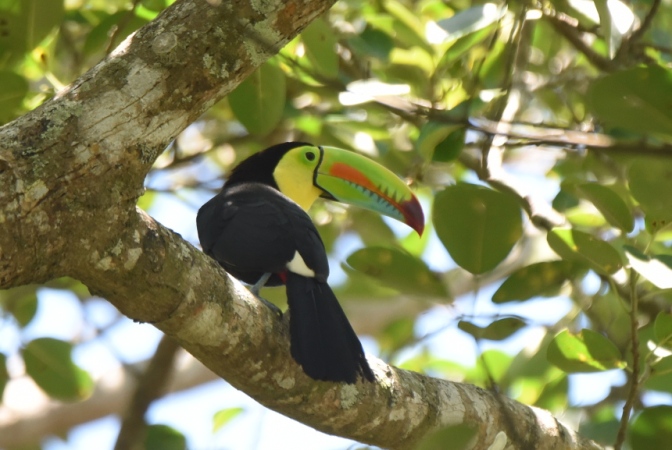
Keel-billed toucan
Beside Alfreds place is an observation platform where we were treated to views of two White hawks on our first morning. They came over the ridge of the hills and landed in some trees not too far away from us.

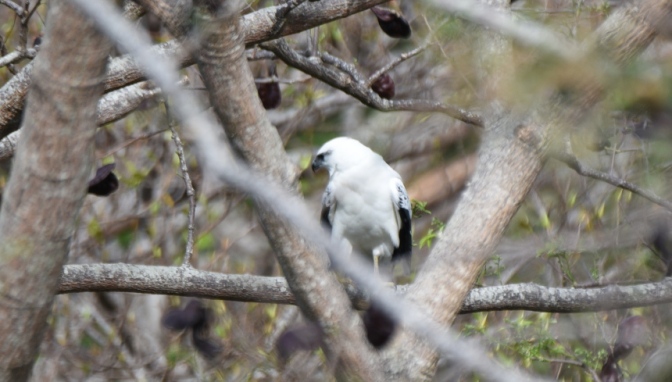
White hawk
A pair of Thick-billed euphonia were busy building a nest on the edge of the upper balcony giving us great views and great photo opportunities. As we sat there, they didn’t seem to mind us at all as they brought grass and other building material to their new nest.
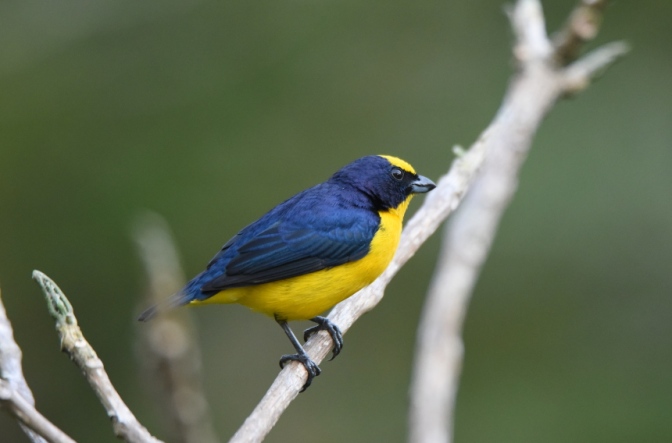
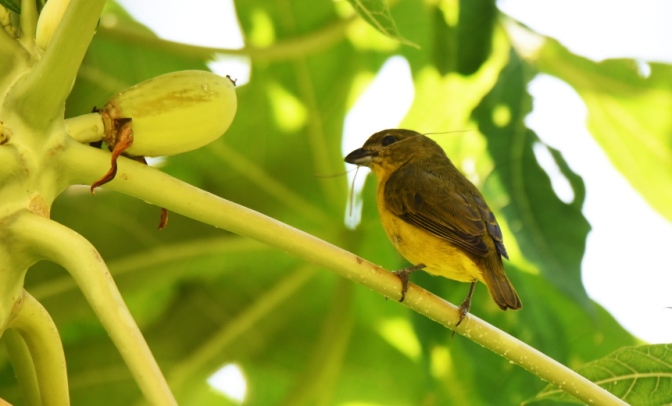
Thick-billed euphonia male and female
If the birds didn’t catch your attention the butterflies did as several species flitted through the garden and landed to check out some flower or bits of ripe banana that we left for them. The Postman butterflies were eye-catching as they interacted with each other on some of the flowers.

Postman
Grey-headed Chachalaca were daily visitors to the garden and could be seen easily climbing through the trees as they foraged for breakfast. It was interesting seeing how easily these large birds went from branch to branch high up in the trees.
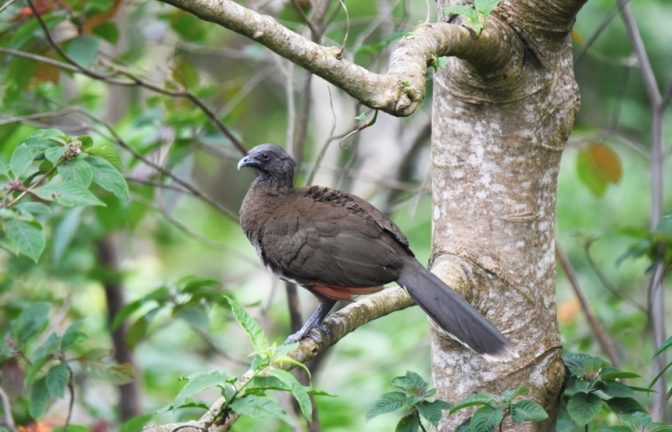
Gray-headed Chachalaca
A warbler we hadn’t seen before was also a regular visitor to the garden. This Rufous capped warbler wouldn’t often stay still for a photo, but we did manage to capture one or two of this pretty bird.

Rufous-capped warbler
Not far from where we were staying was a Chestnut-headed Oropendola colony. These birds are very social, and the tree had several nests hanging from it.
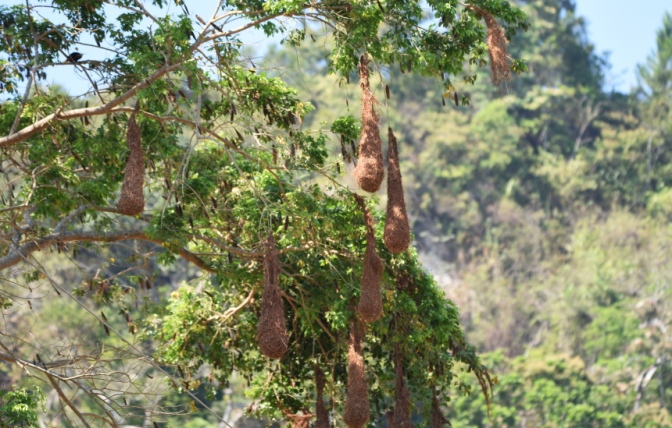

Chestnut-headed Oropendola and nests
During our time sitting and enjoying the birds in the garden the flowers were also worthy of a few photos as you can see from the following few blooms.

Red torch ginger
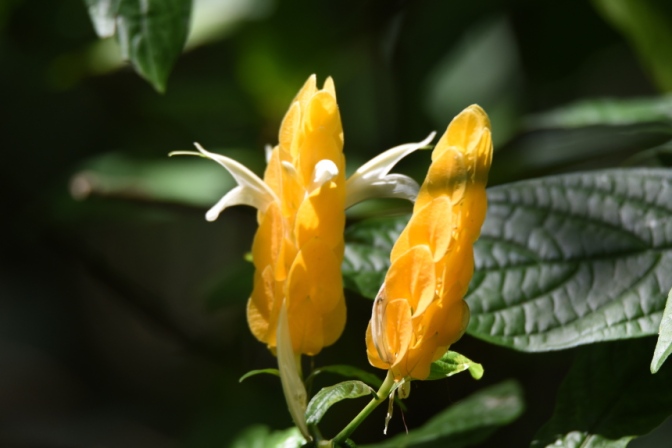
Golden shrimp plant
![]()
Heliconia

Mysore trumpet vine
The new birds of the day just kept adding up as this Tufted flycatcher landed on a branch in front of us on one of our hikes in the area.

Tufted flycatcher
A Social flycatcher and Blue-gray Tanager decided to share the same tree and make for quite a contrast in colours.

Social flycatcher and Blue-gray tanager
We took many photos as we saw many new birds on the very first day of our stay in Altos del Maria. A few of the birds that we just don’t have room to include photos of include Lesser elaenia, Zone-tailed hawk, Crimson-backed tanager, Yellow-bellied elaenia, Red-faced spinetail, Common chlorospingus to name only a few. At the end of the day we had seen 50 species of birds of which most of them were new to us. This was quite the introduction to birding in Panama. Fortunately for us Alfred has a great knowledge of the birds here so he was able to give us some names as we were trying to get good views and even a few photos of these new birds.
As I write this blog now with memories of some of the birds fading a bit, I find that the app Merlin Bird ID is extremely helpful to refresh my memory of the bird names. By using our photos and the Merlin app I can get the correct name for some of the birds that we only saw once or twice. This app from the Cornell Lab of ornithology should be one you put on your phone or pad if you are going to a new country to bird. There are bird packs for it from several of the popular birding countries so get them loaded before you venture out to do some birding far from home.
On the second day in Panama we ventured up higher into the mountains to see new species of birds that inhabit those areas. The small Common Tody-flycatcher was one of the first that we managed to capture a photo of as it was perched looking intently for its next meal.

Common Tody-flycatcher
A Plain Xenops was happily singing from a branch in a tree when we can across it. As birds usually do it soon flew to another perch farther away from us, but we got a photo as it was tuning up its voice.

Plain Xenops
At these higher elevations we see other butterflies and damselflies as they work their way through the jungle greenery seldom posing long enough for a photo. Here are photos of a Narva checkerspot first followed by a Giant Helicopter damselfly. It was indeed a giant and when it flew it was easy to see why it is called a helicopter as its wings moved in a peculiar fashion. With a wingspan of up to 19 centimeters the Helicopter damselfly will certainly catch your eye as it moves through the greenery.

Narva Checkerspot

Helicopter Damselfly
On the way up to a viewing tower we came across this Purple-throated Mountain-Gem that seemed almost as surprised to see us as we were to see it. It is a beautiful little hummingbird and didn’t seem to mind while we snapped a few photos for our blog.

Purple-throated Mountain-gem
At one of the viewing towers we had good views of an Ornate Hawk eagle as well as a Barred hawk as they flew overhead (but also behind vegetation thus preventing good photos). On the way back down we saw a Spotted Barbtail trying very hard to keep out of our view. Then an Ochraceous Wren followed our progress and kept calling as if to say, “find me if you can”. We had very quick views of the wren but no photo ops. Before heading back home for the day we came upon an area with migrating warblers and saw some of our old favourites from home…… Golden-winged, Mourning, Blackburnian, Canada and Wilsons. It was nice to see a few birds we easily recognized. This Silver Throated Tanager was a nice new addition to our growing bird list.

Silver throated Tanager
Even after the sun had gone down and the birds had gone to sleep, we had another new visitor arrive just outside our door. Initially we didn’t know what kind of snake had decided to curl up in the corner but after a quick text to our son he indicated we shouldn’t get too close to this one. It was a Fer-de-Lance and is one of the poisonous snakes found in Panama.

Fer-de-lance
It was just looking for a place to spend the night so after alerting Alfred to its presence we let it sleep peacefully and, in the morning, saw it wind its way down the path and out of sight into the garden to look for some lizards for its breakfast.
I can now see that this blog is going to get rather long if I include all the photos that I initially picked out so some of the birds that we saw I will just mention and you can look them up to get an introduction to some of those interesting birds. Some did pose so nicely though that we just have to include their photos in our blog. One of these is this Orange-bellied Trogon that came out and perched just above us.
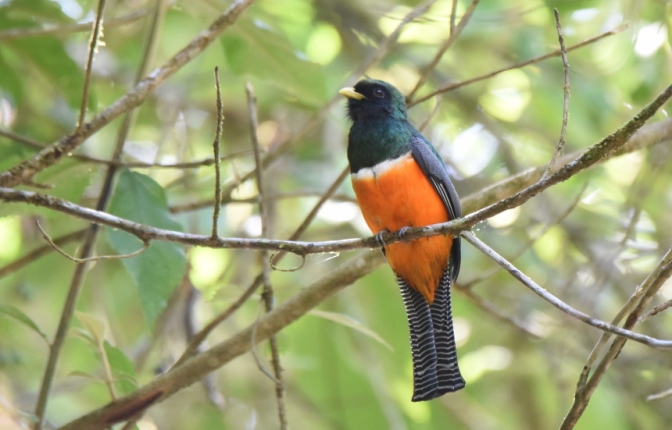
Orange-bellied Trogon
Another interesting one was the Black-cheeked woodpecker that was working away on a new home and didn’t mind us watching it from a distance. Its always nice to have a good telephoto lens so the birds don’t get stressed from being too close to them.

Black-cheeked woodpecker
Other new birds for the day were Squirrel cuckoo, Band-rumped swift, Green hermit, Blue-headed parrot, Chestnut-backed antbird, Tropical pewee, Northern schiffornis, Bay-headed tanager and Green honeycreeper. Only 4 days on the birding trail in Panama and already at 111 species of which many we had to try and learn their names.
The next day we spent in the lowlands near the ocean and headed there early in the morning as the temperature by noon is easily in the 30s C. Due to being in a new habitat many of the 44 species we saw that day were new to us and again the cameras were active trying to get some reasonable photos of these interesting new birds. The Fork-tailed flycatcher was busy eating the fruit in some of the trees along the roadway and you could sometimes get it stopped long enough for a photo.
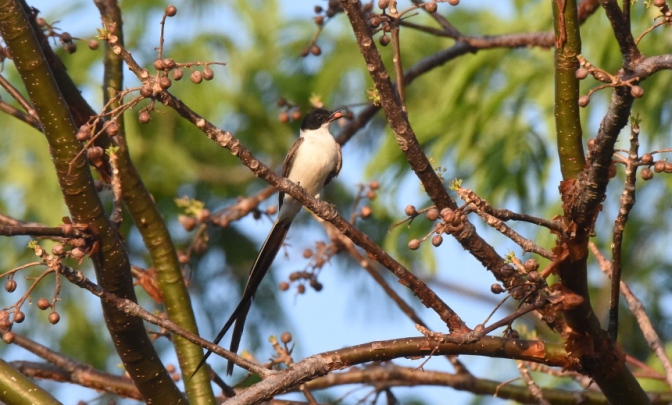
Fork-tailed flycatcher.
This Orange-chinned parakeet was another new bird for our list and gave us good views as it too was having its morning meal. Several of them were moving from tree to tree filling up their bellies.

Orange-chinned parakeet
At least one pair of Barred Antshrike were working the trees along the road as well. This male shows how well suited their name is with all its bright black and white bars. The female of this species is actually more rusty brown but does have some of the barring around its head and eyes.

Barred Antshrike
Along the grassy side of the road a few Crested bobwhite suddenly appeared and then just as quickly disappeared into the long grass. We had a chance to see the beauty of this small grassland bird as it made sure we weren’t going to get any closer to it.

Crested Bobwhite
In this area we saw several species of shorebirds, a few species of terns, herons, egrets, both Smooth-billed and Groove-billed Ani, Crested and Yellow-headed Caracara, Palm Tanagers, Blue-black Grassquit and several other species. Here five days and already 155 species on our eBird list.
The next two days we spent wandering some of the streets around Alfred’s place as he was busy with other activities. We saw several of the same species but got to see some of the interesting houses and roads in that area. Nothing flat here as you are either going up or down along the mountain ridges. We did add White-tipped dove, Long-billed Starthroat, Crimson Collared Tanager and Gray-headed Kite to our list. The Kite cruised in sight overhead just long enough for a quick photo.

Gray-headed kite
At this point we’re going to get this first week in Panama published and then go right to work on the second week and get it out quite soon. Then it’ll be time to try and catch up on our local sightings through the past year…. whew…. getting behind is easy when you see so many new birds on a trip like this one. At this point in time we’re at 163 species so there’s more to come. Bye for now but see you again soon!!
Hi,
Thanks for sharing your pictures. They are fabulous.
Anne
LikeLike
We do love to share our experiences in the birding world Anne. Glad you enjoyed them and there will be more on the way soon.
LikeLike
Oh, I just loved seeing these pictures Bob and Anne-Marie. They brought back so many memories of the time that Mike and I stayed at the Canopy Tower in Panama to bird. We had such a wonderful time. I tested myself going through your pictures to see how many I could remember, and I did pretty well. We did not a Fer-de-lance there though we did see one in Ecuador. Thanks for the pictures and the memories.Helen
LikeLike
So glad that you enjoyed the post Helen. These are the reasons we enjoy doing the blogs….to bring back memories as in your case and to temp others to try birding in another country :). I’m just getting ready to start on the second part of our stay in Panama so there will be more photos soon to test yourself on.
LikeLike
fantastic pics Bob & Anne-Marie. thanks for sharing
Ralph and Mary Ann
LikeLike
Maybe it’s time for a trip to Panama for you 😉. It’s a great place to see some interesting birds.
LikeLike
Hi, gorgeous, thanks for sharing. J
We still need to get to our photos from last August, not easy when you juggle the kids and work. I love your photo of the Keen billed Toucan, ours was taken way up high in Monteverde rain forest at a great distance in the pouring rain, the only rain we saw was there.
Linda
Linda Fraser Waldmann, BSc, DSHM, FSHM, HOM
Classical Homeopath
HOMEOPATHY your pathway to health
519-797-2126
http://www.homeopathywithlinda.com
Lindamyhomeopath@bell.net
“Restoring health in a rapid, gentle and permanent way” like the founder of homeopathy Dr Samuel Hahnemann.
LikeLike
It’s always fun to be able to capture a certain moment with birds and even more to be able to share it with others. Glad you enjoyed it Linda 😄.
LikeLike